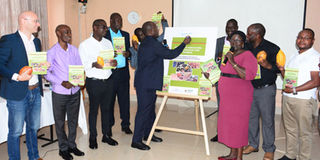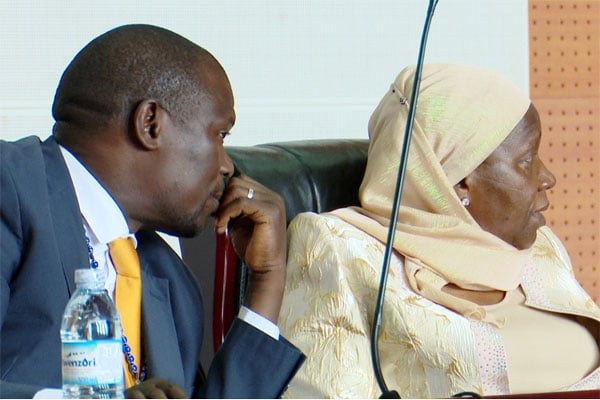Prime
Govt launches handbook to boost cocoa growing

Fred Bwino Kyakulaga, the State Minister for Agriculture, Animal Industry and Fisheries launches the handbook. photo/Godfrey Lugaaju
What you need to know:
Although cocoa is an important crop in Uganda, production per unit area is low and most cocoa farmers are not getting the full benefits from growing the crop. A farm-based manual is expected to rectify some of the problems.
The Ministry of Agriculture, Animal Industry and Fisheries (MAAIF) together with Swisscontact, through its Dynamic Markets for Farmers Project have launched the Cocoa production manual to help extension workers deliver good information and understand agronomic practices of cocoa growing.
Cocoa growing in Uganda has increased, with the value of formal exports growing at a compound annual growth rate (CAGR) of 14.3 percent ($54.2m to $105.8m) between 2017 and 2021.
As such, it has become a significant source of foreign exchange income and a source of livelihood for different stakeholders such as farmers and traders. Despite this contribution to socio-economic development, cocoa productivity is still as low as 2.5kg per tree compared to the optimum of 5kg per tree which can be achieved with the adoption of best practices.
Speaking at the launch last week in Kampala, Fred Bwino Kyakulaga, the State Minister for Agriculture, Animal Industry, and Fisheries, said the global cocoa market is projected to be $80,000m.
He explains that cocoa is an African crop and 70 percent of the global market is taken up by four African countries of Ivory Coast, Ghana, Nigeria and Cameroon.
“Uganda is among the countries with potential to grow cocoa. All districts surrounding lakes Kyoga, Victoria, Edward, George and Albert are all suitable for growing it. I want to call upon the citizenry in these areas to grow the crop,” he says.
Mr Bwino shares that currently, a few districts are growing cocoa and they are not being guided well by extension workers.
“By launching this manual, we are organising extension workers to be able to accurately guide farmers about cocoa from the nursery beds to harvesting and post harvesting handling. Extension workers should wake up and do their work of mobilising and guiding the population working with the private sector to have good high quality cocoa,” he said.
The minister reveals that there is global demand for cocoa and if farmers follow the manual, Uganda will be able to take a fair share of the cocoa market.
“As government, our intervention is to tell the population about the huge global market and I encourage farmers in Uganda to take advantage of this and I have told the country the different places where cocoa can grow well and thrive,” he says.
This manual will help extension workers put out standardised uniform information about the crop to the farmers.
Commitment
Mr Kenneth Aedu, a project manager at Swisscontact says that for the time they have been working in the cocoa sector, the manuals they have been using have not been contextualised in the Ugandan way.
“MAAIF and Swisscontact came up with a document that helps in responsible cocoa production for farmers to manage their cocoa fields well for the next generation. This manual is out of a year and a half’s commitment since we wanted to have information that helps our farmers get more productive,” he notes.
Aedu explains that the manual has about five chapters customising and harmonising information in the Ugandan context. There are also chapters about cost benefit analysis, expected yields and what is required.
He reveals that in their various interactions with cocoa farmers in the field, they found a number of problems that were hindering quality cocoa production.
This is partly attributed to inadequate access to extension and advisory services among cocoa farmers in the country. Extension officers in the districts often lack access to materials guiding cocoa growth.
“Farmers were dealing with seedling quality, the cocoa volume was low, poor quality yields, and having to deal with a number of uncoordinated manuals about growing the crop,” he says.
The manual
The cocoa production manual is intended to harmonise the existing extension materials being used by various actors.
It is aimed at addressing the inconsistency in the delivery of a uniform extension package to primary producers and other actors along the value chain. This will consequently contribute to improved cocoa production, productivity and quality of cocoa, farmers’ income, and export earnings for Uganda.
The manual comprehensively covers topics such as seed selection and management, nursery management, garden establishment and management, harvesting, and post-harvest handling as well as a detailed cost-benefit analysis.
Key fact
In Uganda, cocoa is mainly grown in the districts of Bundibugyo, Mukono, Kayunga, Jinja, Iganga, Mayuge, Buikwe and Masindi. Cocoa is a perennial crop that responds well in rainy tropical areas, with a maximum annual average of 30 - 32ºC. It thrives under shades and in areas with annual rainfall between 1,500mm to 2,000mm.




